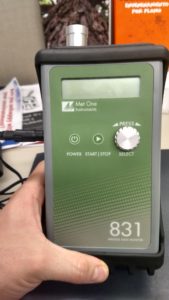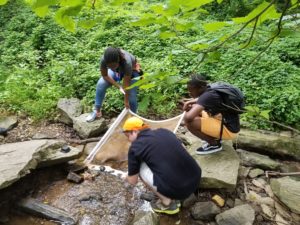The Community Outreach and Engagement Core hosted an Environmental Health week from July 10th –July 14th for West Philadelphia high school students as part of the Netter Center and Center for Public Health Initiatives eight week public health internship. COEC director Dr. Marilyn Howarth and coordinator Tom McKeon taught the interns about environmental health problems by using local examples of the environment’s effect on human health. Each day, COEC communicated a different theme: air quality, environmental justice, water quality and lead. The take-home message for these interns was that it was important to consider the environment’s impact on health in almost everything they do.
The lessons incorporated a didactic introduction of the day’s theme, followed by interactive and hands-on applied science. Students would learn about a particular environmental risk in the local area and then critically consider what they had learned from a global perspective.
The week started with a lesson on sources of poor outdoor air quality. Students explored topics such as illnesses associated with poor air, resources such as www.airnow.gov used to receive air quality alerts, and tools to sample the air for fine particulates. The interns learned about ozone and fine particulates (PM2.5), which are air pollutants measured daily by the Environmental Protection Agency (EPA). Wrapping up the day, the interns took a walk around Penn’s campus measuring PM2.5 using an air monitor and then graphing their results using an online graphing program.
The second day, the interns traveled by bus to attend a Chester Environmental Partnership (CEP) meeting at Faith Temple Holy Church in Chester, PA. The CEP, formed by environmental justice leader, Reverend Horace Strand in 2005, stands as the epicenter for the community’s leaders who work daily for environmental improvements in their neighborhood. The students witnessed community members who were not experts being civically engaged in environmental health problems that mattered to them. After the meeting, the interns toured Chester to gain a broader understanding of the city’s rich history, culture, and environmental problems.
In order to explore water quality and health on the third day, the interns travelled by bus to the Riverbend Environmental Education Center (REEC) in Gladwyne, PA. Getting their hands dirty in a stream, the high schoolers searched for benthic macro invertebrates, also known as “macros”. The students learned that macros, which are the nymph and larvae form of many common “bugs”, make for excellent indicators of a stream’s health. The abundance, diversity, and absence of macros can give a hint into how impaired the stream may be. Frankie Lazauskas, TTF Watershed Partnership Conservation Leader, and Erin McCool, REEC Director of Education, joined COEC Coordinator Tom McKeon in stream sampling, using a standard kick seine net to collect macros. While exploring the stream, the staff and interns discussed the impact of pharmaceutical, biological and chemical pollution on natural water sources, as well as the difficulty of treating toxic pollutants to insure safe water for human consumption.
On the fourth day, the program explored the heavy metal, lead (pb), and its toxic impact on human health. COEC deputy director, Richard Pepino and his graduate students taught the student interns about the environmental sources of lead that can harm people, especially children. Exposures such as lead paint, soil, and dust inhalation from construction were discussed in depth, as they are the exposures of most concern. The interns prepared for this topic by bringing in their own soil samples from home to be tested using an X-ray Fluorescence machine, otherwise known as an XRF. The XRF uses energy to excite electrons within atoms in order to identify particular elements in concentrations of parts per million (ppm). A lead soil reading of 400 ppm or higher is a cause of concern for soil in which children play, according to the EPA. The lead soil concentrations in this group’s home samples ranged from 49 ppm to 929 ppm. Students whose samples came back with an elevated lead concentration were offered follow up contact information for their family.
GIS Map of Lead Soil Sampling Results
On the last day we asked the students to reflect on the week’s overarching question of: “What Would Surprise Your Friends About Environmental Health?” The interns took out their notes from the week and chose to write haikus, provide ideas for this blog, or create a short video on what they learned that would surprise their friends. Here are some of their thoughts:
My friends would be surprised:
air pollution can affect your lungs
about how much lead is in the soil
that there are multiple oil spills in the US every day
there can be lead in imported toys and candy
window sills can expose children to lead paint dust
there are electric cars
I would recommend to my family and friends:
get children who are 1 and 2 tested for lead
sign up for air quality alerts at: airnow.gov so when the air quality is bad you don’t play outside
stop smoking
stop idling your car to reduce air pollution
check your house for lead
don’t dump your left over medicine in the toilet
remind brothers and sisters to leave their shoes at the door
wash hands after playing outside
run water for 5 minutes before you use it
Explore their haiku and video submissions below:
Haikus: https://upenn.box.com/s/u5scn0jd9mv71rnu3u12xnf8tkbmyyy1
Video: https://upenn.box.com/s/ui4lneo3zpkwg2ni0p2rbz9te8mythyr






